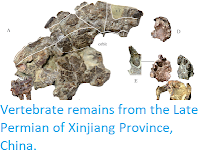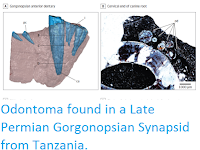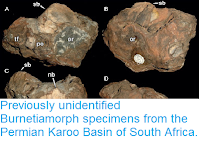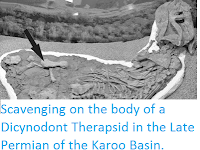Caudal autotomy is a process by which a vertebrate animal sheds its tail, or a portion of it, in order to escape from a predator. Today it is seen only in Lepidosaurs (Lizards, Snakes and the Turatura), suggesting that it is a unique innovation in this group. Caudal autotomy can occur intravertabrally (through the vertebrae), as seen in the Turatura and most Lizards, or intervertebrally, between the vertebrae, as seen in Agamid Lizards and Snakes.
In a paper published in the journal Scientific Reports on 5 March 2018, Aaron LeBlanc of the Department of Biology at the University of Toronto Mississauga, and the Department of Biological Sciences at the University of Alberta, Mark MacDougall, Yara Haridy, and Diane Scott, also of the Department of Biology at the University of Toronto Mississauga, and Robert Reisz of the Dinosaur Evolution Research Centre at Jilin University, describe evidence for the presence of caudal autotomy in Permian Captorhinids, a Eureptilian group (i.e. animals more closely related to modern Reptiles and Birds than to Mammals, but which split off from the ancestors of these modern animals long before the split between Archosauromorphs (Crocodiles, Birds and Turtles) and Lepidosaurs (Snakes, Lizards and the Turatura).
LeBlanc et al. examined 70 isolated or pairs of Captorhinid caudal (tail) vertebrae from the Royal Ontario Museum collections, obtained from the Early Permian Richards Spur locality at the Dolese Brothers Quarry in Oklahoma. They found that these had a line of weakness, which would apparently allow for caudal autotomy, with a potential line of fracture through the bottom part of the vertebrae. This appeared to be well developed in younger individuals, with the bone becoming more densely mineralised as the animals grew older, suggesting that fully mature individuals lost the ability to autotomise their tails, as is the situation in modern Iguanas.
Intravertabral caudal autotomy (breaking off of the tail through the vertebrae) is generally associated with animals that can regrow their tails. No sign of any such regrowth was seen in any Captorhinid examined, though this does not necessarily imply that they were not capable of such recovery, as all of the specimens from the Richards Spur locality are isolated vertebrae rather than entire skeletons, which would make such preservation unlikely, and even were this not the case, the proportion of animals with recovering tails in the population would presumably be quite low, making the likelihood of such an animal being preserved equally low.
LeBlanc et al. examined 70 isolated or pairs of Captorhinid caudal (tail) vertebrae from the Royal Ontario Museum collections, obtained from the Early Permian Richards Spur locality at the Dolese Brothers Quarry in Oklahoma. They found that these had a line of weakness, which would apparently allow for caudal autotomy, with a potential line of fracture through the bottom part of the vertebrae. This appeared to be well developed in younger individuals, with the bone becoming more densely mineralised as the animals grew older, suggesting that fully mature individuals lost the ability to autotomise their tails, as is the situation in modern Iguanas.
Fracture planes in Captorhinid caudal vertebrae. (a) Artist’s reconstruction of the Permian Reptile Captorhinus with an autotomous tail (inset showing anterior caudal vertebrae with fracture planes). (b) Image and (c) SEM image of an isolated anterior caudal vertebra with a fracture plane passing through the centrum (black arrow). (d) Ventral view of an anterior, rib bearing caudal vertebra showing the absence of any fracture plane. (e) Ventral view of a caudal vertebra bearing a fracture plane (black arrows) (f) thin-section through the sagittal plane of a caudal vertebra with a fracture plane (black arrow) passing through the ventral portion of the centrum. (g) Close-up of fracture plane (black arrows) in (f) passing into the notochordal canal. Abbreviations: cb, cortical bone; cct, calcified cartilage; ce, centrum; nc, neural canal; ns, neural spine; ntc, notochordal canal. Reconstruction by Danielle Dufault. Anterior is to the left in all of the images. LeBlanc et al. (2018).
Intravertabral caudal autotomy (breaking off of the tail through the vertebrae) is generally associated with animals that can regrow their tails. No sign of any such regrowth was seen in any Captorhinid examined, though this does not necessarily imply that they were not capable of such recovery, as all of the specimens from the Richards Spur locality are isolated vertebrae rather than entire skeletons, which would make such preservation unlikely, and even were this not the case, the proportion of animals with recovering tails in the population would presumably be quite low, making the likelihood of such an animal being preserved equally low.
See also...
Follow Sciency Thoughts on Facebook.







